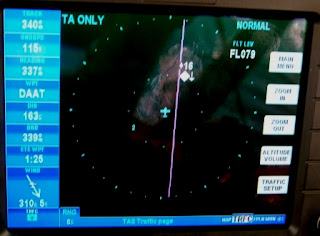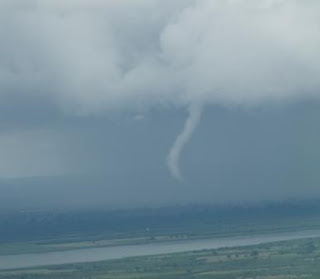March 28
Agadez, Niger to Tamanrasset, southern Algeria
381 nautical miles
Flying time 3 hours 29 minutes
 |
| Alpha Charlie and one of the other Foxes 1800ft above en route to Tamanrasset in the soup |
Alpha Charlie crosses into Algeria, our last country in Africa, at precisely 09:45 UTC. There is high ground ahead. We’re in the soup again. No visibility forward at FL85 (8500 feet) and virtually none below. Ahead the ground rises eventually to over 4500 feet at Tamanrasset airport.
Maintaining separation between aircraft flying around the same level from the same place to the same destination is (literally) vital. My mate Laurie Kay has been passing anxious messages via Johannesburg control (Gilly) to keep a good lookout in this neck of the woods.
My “entry-level” Avidyne TAS600 TCAS traffic alert system really earns its keep today. Keeping a good lookout is fine when you can see outside. But in an IFR situation it’s a lifesaver. The way it works (pilots fast forward here) is by “ interrogating” other aircraft fitted with transponders within a 7nm range and which are 3500ft above or below you. These then show up as little white or black diamond on your GPS. Or a yellow dot if it’s going to bump into you within 30 seconds - assuming both aircraft maintain the same heading and level. A female voice then says “ Traffic. Traffic. 2 o’ clock high/or low/or same altitude”. Bit shrill. I’m thinking of customising the voice to Joanna Lumley’s. No it won’t tell you if there’s a glider without a transponder or a flock of geese in your way. And yes I understand it’s no substitute for looking out of the window. But, today, it allowed Alpha Charlie to stay clear of the other Foxes until we started our slow descent into Tamanrasset and onto a downwind join for runway 20 left. I think was of some use to the formation.
 |
| Where Europe's nuclear industry has been getting most of it's uranium from for 40 years |
On the way to Tamanrasset, just before we cross the border with Niger, is a vast uranium mine at a desolate spot in the desert called Arlit. Niger produces around 8% of the world’s uranium output. Production, controlled by the French. It has fed Europe’s nuclear power needs for 40 years. Tuareg tribesmen have launched repeated attacks in the area. They want their share. The government responds with force, probably using the revenues from the mine to buy weapons. The big Cessna goes down to take a look. Adam, riding with Helmut, says the mainly open-cast mine is “ vast”.
Tamanrasset is another desert oasis. It is in the spectacular Ahaggar mountains. In some places they resemble Monument Valley in Arizona, rising majestically out of the desert. It is on the trans-Saharan trade route. Despite the fierce temperatures (in August these can reach 48 degrees celcius) citrus fruits, almonds, dates and figs grow here.
The town is also now the headquarters for the Joint Military Staff Committee co-ordinating the fight against Al Qaeda and powerful cocaine cartels in the area. It’s nice to know the cartels have a sense of history and are keeping the old trade routes alive.
Just north of here, deep in the Sahara desert, is a US military base. Just after we land, a Hercules aircraft touches down on runway 20. It taxis just past the formation and disgorges a small flood what are probably Americans who exit quickly and discreetly in single file and disappear into the other end of the terminal building.
One other thing. Michael Palin was here on a recent trip. So we follow in the footsteps of great explorers yet again.
Two days to go to Ibiza. And then home









































